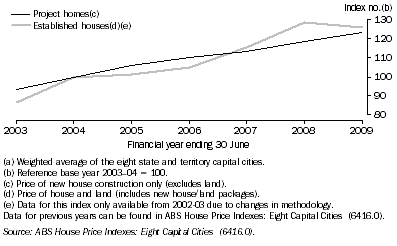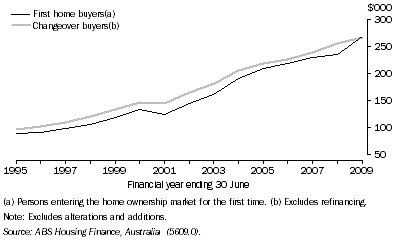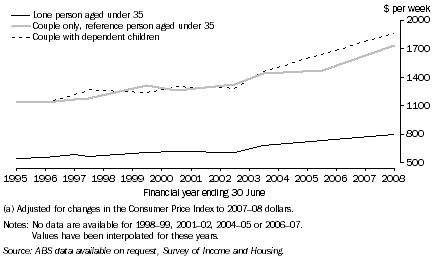HOME BUYERS
For most Australians, buying a home involves raising a deposit then borrowing a substantial amount of money from a bank or other lending institution which then holds a mortgage on the property. The amount borrowed is influenced by a number of factors including the price of the property, the amount of deposit, the policy of lenders regarding borrowing limits, and the ability of the borrower to repay the loan (which is in turn influenced by household income and housing loan interest rates).
During the period from 1994-95 to 2008-09 the number of dwellings financed grew considerably. In 2008-09, banks and other lending institutions financed 680,000 dwellings for owner occupation, 55,000 less than in the previous year, but still 50% higher than in 1994-95. While the number of established dwellings financed has grown from 348,000 in 1994-95 to 594,000 in 2008-09, the number of new dwellings financed for construction or purchase has declined from 103,000 to 85,000 over the same period (graph 10.14). In 2008-09, new dwellings represented 12% of all dwellings financed in Australia. Western Australia had the highest proportion of new dwellings financed (16%) and New South Wales had the lowest (9%).
10.14 Dwellings financed(a)

Between 2002-03 and 2008-09 project home prices increased by an average of 32%, while established house prices increased by an average of 45%. Movements in established house prices were more volatile. They increased from 2002-03 to 2003-04, levelled off until 2005-06, again increased until 2007-08, in line with the rise in established home purchases, but declined in 2008-09 (graph 10.15).
10.15 House price indexes(a)

Average loan sizes increased along broadly similar lines to house prices between 1994-95 and 2008-09. For most of the period, the average loan size of first home buyers was slightly less than changeover buyers (graph 10.16). However, in 2008-09, first home buyers' average borrowings exceeded that of changeover buyers, with first home buyers borrowing an average of $269,000, $3,000 more than the average loan size of changeover buyers.
10.16 Average loan size

Differences in average loan sizes between states and territories tended to reflect differences in median house prices (table 10.17). Average loan sizes in 2008-09 were highest in New South Wales ($275,000) and Western Australia ($266,000), and lowest in Tasmania ($182,000).
10.17 HOUSING FINANCE FOR OWNER OCCUPATION, HOUSE PRICES AND PROPERTY VALUES |
|
 |  |  | NSW | Vic. | Qld | SA | WA | Tas. | NT | ACT | Aust. |
|
| Dwellings financed - 2008-09 |  |  |  |  |  |  |  |  |  |  |
 | New dwelling built or
purchased(a) | '000 | 18.0 | 24.6 | 18.3 | 6.9 | 13.3 | 1.6 | 0.5 | 1.4 | 84.7 |
 | Established dwelling purchased(b) | '000 | 188.7 | 134.3 | 123.0 | 51.4 | 685.9 | 12.5 | 4.9 | 10.4 | 593.8 |
 | All dwellings financed | '000 | 206.7 | 158.9 | 141.3 | 58.3 | 818.8 | 14.1 | 5.5 | 11.9 | 678.5 |
| Average loan size - 2008-09 |  |  |  |  |  |  |  |  |  |  |
 | First home buyers(c) | $ '000 | 284 | 252 | 279 | 236 | 279 | 191 | 279 | 291 | 269 |
 | Non-first home buyers | $ '000 | 272 | 246 | 258 | 204 | 261 | 180 | 258 | 248 | 253 |
 | All dwellings financed | $ '000 | 275 | 248 | 263 | 210 | 266 | 182 | 263 | 256 | 257 |
| Change in capital city Project Home Price Index from 2002-03 to 2008-09(d) | % | 22 | 17 | 45 | 28 | 68 | 41 | 61 | 29 | 32 |
| Change in capital city Established House Price Index from 2002-03 to 2008-09(e) | % | 10 | 54 | 85 | 77 | 118 | 105 | 117 | 49 | 46 |
| Median price of capital city established house transfers - March Qtr 2009(f) | $ '000 | 447 | 375 | 400 | 353 | 430 | 300 | 455 | 461 | na |
| Median estimated value of all owner occupied dwellings 2007-08(g) |  |  |  |  |  |  |  |  |  |  |
 | Capital city | $ '000 | 550 | 420 | 450 | 350 | 520 | 310 | 400 | 450 | 450 |
 | Balance of state | $ '000 | 340 | 260 | 400 | 285 | 400 | 250 | na | na | 320 |
 | Total state | $ '000 | 435 | 360 | 400 | 330 | 500 | 270 | 380 | 450 | 400 |
| Average amount of mortgage outstanding - 2007-08(h) |  |  |  |  |  |  |  |  |  |  |
 | Capital city | $ '000 | 243 | 160 | 191 | 150 | 177 | 136 | 174 | 170 | 192 |
 | Balance of State | $ '000 | 142 | 123 | 157 | 107 | 143 | 89 | na | na | 139 |
 | Total | $ '000 | 207 | 149 | 173 | 140 | 169 | 107 | 169 | 170 | 173 |
|
| na not available |
| (a) A new dwelling is one that has been completed within twelve months of the lodgement of a loan application, and the borrower will be the first occupant. |
| (b) An established dwelling is one that has been completed for twelve months or more prior to the lodgement of a loan application, or that has been previously occupied. |
| (c) Persons entering the home ownership market for the first time. |
| (d) Measures change in the cost of building a new house on buyer's own land. |
| (e) Measures change in prices paid for house and land, including new house/land packages. |
| (f) Prices paid for established houses (including land) purchased in the reference period. |
| (g) Householder's own estimate of the market value of their dwelling at the time of the survey. |
| (h) Only includes owners with a mortgage. |
| Source: ABS Housing Finance, Australia (5609.0); ABS House Price Indexes: Eight Capital Cities (6416.0); ABS Housing Occupancy and Costs, Australia (4130.0). |
Between 1994-95 and 2007-08, the average real disposable income of households who were lone persons under 35 years increased by 47%. That of couple-only households with a reference person under 35 years increased by 52%, and that of couples with dependent children increased by 64% (graph 10.18). In the same period, the average loan size, after adjustment for inflation, increased by 56%.
10.18 Average real disposable household income(a)

About 1.0 million Australian households bought a home in the three years prior to the 2007-08 Survey of Income and Housing conducted during the twelve months ended June 2008. Thirty-two percent of these were first home buyers, most of whom were young households with a reference person aged under 35 years (64%) (table 10.19). Less than 10% of first home buyer households had a reference person aged 45 years and over. In contrast, more than half (53%) of changeover buyer households had a reference person aged 45 years and over.
Changeover buyers are able to use the often substantial equity in their previous dwelling as a deposit on a more expensive 'upgrade'. Many will be able to discharge their mortgage quickly and some may not need to borrow at all. In 2007-08, the estimated median value of dwellings occupied by changeover buyers was $420,000 compared with $350,000 for first home buyers.
While changeover buyers occupied more expensive homes than first home buyers, they had smaller mortgages ($231,000 compared with $251,000) and were more likely to own their home outright.
Consequently, average weekly housing costs of first home buyers were higher than for changeover buyers - $471 compared with $365. First home buyers also spent a larger proportion of household income on housing than changeover buyers - 24% compared with 16%.
10.19 RECENT HOME BUYERS(a), Selected household characteristics - 2007-08 |
|
 |  |  | Recent home buyers |  |
 |  |  |  |
 |  |  |
|  |
 |  |  | First
home
buyer(b) | Changeover buyer(c) | All recent
home
buyers | All owner households |
|
| Proportion of households with reference person aged |  |  |  |  |  |
 | Under 35 years | % | 63.9 | 16.6 | 31.8 | 11.4 |
 | 35-44 years | % | 26.2 | 30.4 | 29.0 | 19.6 |
 | 45-54 years | % | *6.0 | 22.0 | 16.8 | 22.9 |
 | 55-64 years | % | *1.6 | 17.6 | 12.4 | 20.2 |
 | 65 years and over | % | **2.2 | 13.5 | 9.8 | 25.8 |
| Proportion of households in selected family/household groups |  |  |  |  |  |
 | Lone person | % | 24.0 | 20.5 | 21.6 | 20.7 |
 | Couple only | % | 31.1 | 29.9 | 30.3 | 31.1 |
 | Couple family with dependent children | % | 31.7 | 33.3 | 32.8 | 29.8 |
 | One parent with dependent children | % | *4.1 | 4.7 | 4.5 | 3.4 |
| Proportion of households that built/purchased a new dwelling(d) | % | 8.9 | 16.8 | 14.3 | na |
| Estimated mean value of dwelling(e) | $'000 | 357 | 521 | 468 | 493 |
| Estimated median value of dwelling(e) | $'000 | 350 | 420 | 390 | 400 |
| Proportion of households with a mortgage | % | 92 | 72 | 78 | 51 |
| Mean amount of mortgage outstanding(f) | $'000 | 251 | 231 | 239 | 173 |
| Average weekly housing costs | $ | 471 | 365 | 400 | 213 |
| Housing costs as a proportion of income | % | 24 | 16 | 18 | 12 |
| Estimated number of households(g) | '000 | 317.8 | 668.2 | 986.1 | 5 514.4 |
|
| * estimate has a relative standard error of 25% to 50% and should be used with caution |
| ** estimate has a relative standard error greater than 50% and is considered too unreliable for general use |
| na not available |
| (a) Households that built or purchased their dwelling in the three years before the survey. |
| (b) Recent home buyer households in which neither the reference person nor their partner had previously owned a dwelling. |
| (c) Recent home buyer households in which either the reference person or their partner had previously owned a dwelling. |
| (d) A dwelling is new if it was built under contract for the current owner or purchased from a builder/developer and the current owners are the first to live in it. |
| (e) Householder's own estimate of the market value of their dwelling at the time of the survey. |
| (f) Only includes owners with a mortgage. |
| (g) Includes all family and household groups. |
| Source: Source: ABS data available on request, Survey of Income and Housing. |
 Print Page
Print Page